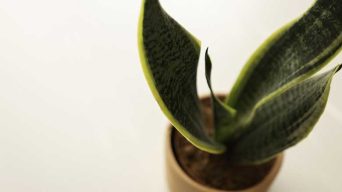Aloe plants are pretty hardy, but they can also be a bit finicky and more prone to some problems than others.
They are so easy to grow that many people forget how important it is to properly take care of them and provide the right environment for them to thrive.
If you’re having problems with your Aloe Vera plant and it seems like it’s dying, there are several things that you can do to revive it.
Learning how to revive a succulent is easy, and in most cases, it can be done with just a few simple steps.
Here are seven common problems Aloe plants experience and how to fix them.
How To Revive an Overwatered Aloe Plant
Overwatering succulents is a widespread issue, with aloe plants being especially susceptible to excessive watering.
Like other succulents and cacti, Aloe plants store water in their leaves. This water is released slowly into the soil and helps them survive prolonged droughts.
However, they can only store so much water, so if they’re constantly given too much water, the roots can’t absorb anymore, and the succulent plant will start to drown and develop root rot.
If you overwater your Aloe plant or give it too much water in one day, the succulent leaves will start turning yellow, soft, and mushy, and the roots will rot.
The tips of their leaves also tend to turn brown and start curling.
These are signs that the plant has been overwatered, and it needs to be taken care of quickly for it not to die.
There are a few things that you can do to revive an overwatered Aloe plant:
- Cut back on the watering. Aloe plants don’t need a lot of water to survive, so reducing the amount you give them should help.
- Let the plant dry out before watering it again. Wait until the top inch of soil is completely dry before giving it any more water.
- Use well-draining potting soil. This will help prevent water from sitting in the soil, which can lead to overwatering.
- Use a pot with drainage holes. If you have an Aloe plant in a container, make sure the pot has some hole or lip at the bottom to allow water to drain out.
- Repot your Aloe into fresh soil (this will require removing all the old soil). You can also add gravel and sand around the plant base to help with drainage.
- Move the plant to a brighter location. Aloe plants need plenty of sunlight to thrive, so try moving it to a spot where it will get more light.
If you follow these tips, your overwatered Aloe Vera plant should start to recover within a few weeks.
How To Save an Underwatered Aloe Vera Plant
An underwatered succulent plant is not as common as an overwatered one, but it can still happen.
Aloe plants are naturally drought-tolerant, but they still need water to survive. They need to be watered every week to two weeks, depending on how hot and dry it is.
Only water when the top inch of soil is dry to the touch. If you water too often, the roots will rot, and the plant will die.
If you don’t water your Aloe plant enough, the leaves will start to turn yellow and brittle, and the tips will begin to curl.
The plant’s fleshy leaves will also shrink and become wrinkled, shriveled, or even split open in some cases.
You need to take care of your Aloe before it dries out completely, as this can cause severe damage that might not be reversible.
If you notice any signs of underwatering, take action quickly to save your plant.
Here are a few things that you can do:
- Water the succulent more often. Aloe plants need to be watered every one to two weeks, so start watering them more frequently until the top inch of soil is moist. Make sure to only water when the top inch of soil is dry.
- Increase the humidity by placing it on a tray filled with pebbles and water. Make sure the pot is sitting on the pebbles and not in the water. The plant will drink from the water through the evaporation process.
- Place the plant in a bright location with indirect sunlight. Aloe plants need plenty of light, but they can’t handle direct sunlight.
- Spread a thin layer of gravel over the soil surface. The coolness from the stone will help keep moisture in the air around it and prevent rapid drying out.
- Put it in a cool location. This can slow down the plant’s metabolism and help its transpiration rate, reducing water loss from the leaves.
How To Revive a Sunburned Aloe Plant
Aloe plants, like most succulents, are susceptible to sunburn during hot summer months.
Although Aloe plants are drought-tolerant, they can’t handle too much hot direct sunlight.
Aloe plants need at least four hours of direct sunlight a day, but no more than six. They thrive in bright indirect light, with some morning and evening sun.
If your Aloe plant is sunburned, the leaves will appear leathery and brown. They may even have burn brown spots on the succulent leaves and turn black at their tips. Also, the leaves will be drooping and withering.
If your Aloe plant is sunburned, you need to take steps to revive it.
Here are a few things that you can do:
- Move the plant to a shadier location. If it’s not too damaged, move it to an area with less than four hours of direct sunlight each day.
- Water the plant. If your Aloe is sunburned, it has likely been underwatered for a long time. Watering will help boost its immune system and heal burn marks on leaves.
- Cut back any damaged parts of the plant with sharp scissors to promote new growth. Remove all dead or dying leaves from around the base of the plant.
- Apply a commercial succulent or Aloe Vera gel to the leaves. This will help soothe and heal any sunburned areas.
If you follow these steps, your Aloe plant should start to revive within a few weeks.
Be patient, as new leaves may take a while to grow back.
How To Revive a Frozen Aloe Plant
Aloe plants are susceptible to freezing during cold winter months.
Although Aloe plants can handle temperatures down to about 25 degrees Fahrenheit, they will start to die if the temperature dips below that.
Frost damage to an aloe plant might manifest itself in various ways.
The leaves might become brown or yellow, and the texture of the leaves may change from firm and leathery to squishy and mushy.
If your Aloe plant shows signs of frost damage, you need to take steps to revive it.
Here are a few things that you can do to revive a frozen Aloe plant:
- Move the plant to a warmer location. If you can’t move it indoors, try moving it to a spot that receives more sunlight.
- Trim off any brown or yellow leaves.
- Carefully remove the rest of the leaves from their stems. Scrape off any brown parts and brush the leaf clean with a soft bristle brush or cloth. Don’t use soap!
- Avoid watering your plant until it shows signs of life, such as new growth. Water that freezes will do more damage than good to your plant.
- If possible, move the plant to a sunny window or outside when temperatures are above freezing again. The warmth will help it recover faster, and new growth should appear within a few weeks.
- Avoid fertilizing a frozen Aloe plant. Fertilizing a frozen or stressed plant can do more harm than good.
If you follow these steps, your Aloe plant should start to look and feel better within a few weeks.
How To Revive a Drooping Aloe Plant
Aloe plants can droop for a variety of reasons, such as:
- Overwatering or underwatering
- Too much sun, or not enough sun.
- Cold temperatures
- Fungal infection
- Insect infestation
If your Aloe plant is drooping, the first thing you need to do is figure out the cause. Once you know the reason, you can take steps to revive your plant.
Here are a few things that you can do to revive a drooping Aloe plant:
- Check the soil for moisture and water as needed, but avoid overwatering or underwatering your plant. If the soil is dry, water your plant until the soil is saturated, and then allow the top inch of soil to dry out before watering again.
- Move the plant to a location that receives more or less sun, as needed. Aloe plants need at least six hours of sunlight per day. A bright window is okay, but avoid placing your plant in direct sunlight.
- If the temperature is below 50 degrees Fahrenheit, move your plant to a warmer location. If you can’t move it indoors, try moving it to a spot that receives more sunlight.
- Apply a fungicide to your plant. The most common fungus that infects an Aloe plant is Powdery Mildew and can be treated with a fungicide like neem oil.
- Inspect your plant for insects, and treat if necessary. Common pests that infest Aloe plants are mealybugs, aphids, and whiteflies. Treating the plant with insecticidal soap or horticultural oil will get rid of these pests.
If you cannot revive your succulent, repotting it into fresh soil will help.
Using a good quality potting mix appropriate for cactus and succulents is critical when you’re repotting an Aloe plant.
A mixture of one part sand or perlite with two parts soil will work well. Don’t water your plant for one week after repotting it to give the roots time to re-establish.
How To Revive a Rotting Aloe Plant
If your Aloe plant is rotting, it’s likely because the soil was kept too wet.
Aloe plants rot easily if their roots are not allowed to dry out between watering cycles.
Also, if the potting mix is too dense, it will not allow the soil to breathe and can cause your plant to rot.
If your Aloe plant is rotting, try the following:
- Repot the plant in fresh soil. Ensure that the potting mix is well-draining and does not contain any fertilizers. A cactus soil mix or potting mix made for succulents is perfect.
- Allow the plant to dry out between waterings. Do not water more than once a week, and only water if the soil feels dry to the touch.
- Place your Aloe plant in a bright, sunny spot. Aloe plants need sunlight to thrive. A place exposed to at least four hours of sunlight a day will do.
- Make sure to use a pot with good drainage holes in the bottom. Aloe plants do not like to sit in water and can rot quickly if the soil is constantly wet.
If you follow these tips, your Aloe plant should start to revive within a few weeks.
How To Revive an Aloe Plant Without Roots
If your Aloe plant has lost its roots, there is still hope. You can try to propagate the plant by leaf cuttings.
To propagate an Aloe plant without roots, try the following:
- Take a leaf cutting. Cut off a healthy, fleshy Aloe leaf from your plant.
- Dip the end of your leaf into a rooting hormone (You can use honey as a natural rooting hormone). This will help the cutting to root more quickly.
- Place your Aloe leaf in a container with fresh potting soil and well-draining holes at its bottom.
- Keep the soil moist but not wet. Aloe plants do not like to sit in water and can rot easily if the potting soil is constantly wet.
- Place your container in a bright location but not in direct sunlight.
- Within a few weeks, you should see new growth on your Aloe leaf cutting. Once the plant has established itself, you can replant it in soil with better drainage.
Aloe plants are easy to propagate and very forgiving if you make mistakes.
So don’t be discouraged if your first attempt at propagating an Aloe plant without roots doesn’t work. Just try again!
Final Thought
Learning how to revive a dying Aloe plant can be easy if you know what to look for and solve these common problems.
Aloe plants are relatively easy to take care of, and they are great for everyone looking for a super unique indoor plant.
With a little bit of effort, you can bring your Aloe plant back to life!
But if your Aloe plant is beyond saving, don’t worry – you can always propagate it to create a new plant.







